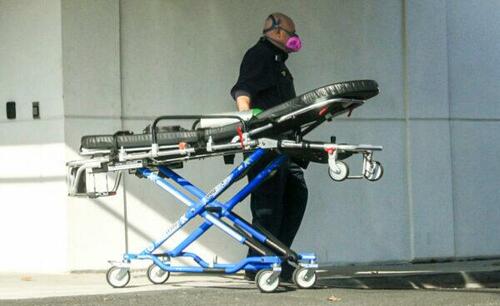Authored by Petr Svab via The Epoch Times (emphasis ours),
The increase in deaths not attributed to COVID-19 in the working-age population during the summer and into the fall of last year hit white-collar workers more than the blue- and grey-collar ones, according to life insurance data.
In the white-collar sector, mortality jumped 24 percent in the period the data pertained to (April 2020-September 2021). Less than 64 percent of those were attributed to COVID-19. In the blue-collar sector, mortality increased by 19 percent, of which over 80 percent was attributed to COVID-19.
Insurance company Q1 group life loss ratios vs 2019. Down from mandate death spikes but still elevated at 20%-30%. $SCI funeral contract volume was 17% above Q1 2020. $HIG 24%$LNC 32%$MET 22%$PRU 24%
So looks like 20% excess deaths in Q1. If that continues very no bueno.
— Ed ☯️Free Thinker & Oracle (@DowdEdward) May 7, 2022
As The Epoch Times previously reported, prime-age mortality was particularly elevated in the 12 months ending October 2021, where there was an excess death spike of more than 40 percent in ages ranging 18–49, compared with the same period in 2018–2019, based on death certificate data from the Centers for Disease Control and Prevention (CDC). The majority of the excess deaths weren’t attributed to COVID-19.

A recent study by the Society of Actuaries (SOA), an international professional organization, corroborates the CDC data. It relies on a survey of group term life insurance providers that yielded data on claims made from 2017 to 2021 and reported to insurers by Sept. 30, 2021 (pdf).
The life insurance data show an increase in excess mortality since the second quarter of 2020, along with the COVID-19 pandemic, including a particularly sharp hike in the third quarter of 2021—39 percent above what would have been expected based on 2017–2019 data. That quarter was exceptionally devastating for age groups 25–34, 35–44, 45–54, and 55–64, in which mortality soared 81 percent, 117 percent, 108 percent, and 70 percent above the baseline respectively.
Deaths attributed to COVID-19 accounted for about three-quarters of the excess mortality during the 18 months the study looked at. But among those under the age of 45, COVID-19 accounted for less than 38 percent of the excess deaths, the study says.
🚨🚨Met Life $MET Group life loss ratio remains very elevated at 22% higher than 2019 levels & down only 200 bp from Q4. More importantly they are citing elevated excess non-Covid 19 mortality while also saying less Covid deaths under age 65 in Q1 versus Q4. So not Covid 🤔🤡 pic.twitter.com/rSN7cCknOr
— Ed ☯️Free Thinker & Oracle (@DowdEdward) May 7, 2022
Among industries with the largest number of COVID-19 deaths, the worst hit was public administration with nearly 13,000 life insurance claims related to the disease. Yet those only accounted for less than 52 percent of the sector’s excess mortality, which rose 24 percent during the pandemic months.
Several other white-collar industries also experienced high excess mortality—22 percent in both doctors’ offices and educational services. COVID-19 claims accounted for nearly 80 percent and 70 percent of the spike respectively.

By contrast, in heavy and steel manufacturing mortality rose by 9 percent, with COVID-19 more than accounting for the entire spike. In fact, non-COVID-19 mortality dropped by a few percent in this sector.
The insurance data aren’t directly comparable to the CDC data because the population covered by group life insurance policies differs from the general population. Since the policies are commonly offered by employers, the overall population weighs disproportionately toward working-age adults.
The study didn’t go into detail on non-COVID-19 causes of the excess deaths.
The CDC has not yet released fully detailed cause-of-death data for the recent period, but a previous analysis by The Epoch Times, informed by conversations with state authorities and experts, revealed several potential causes of the excess mortality, including undercounted COVID-19 deaths, drug overdoses, alcohol-related disease, and injuries possibly caused by the COVID-19 vaccines.











